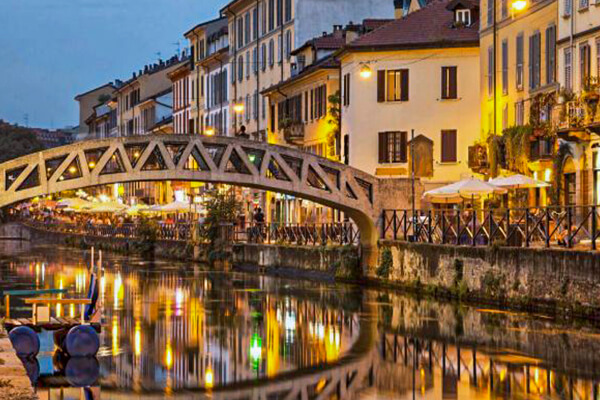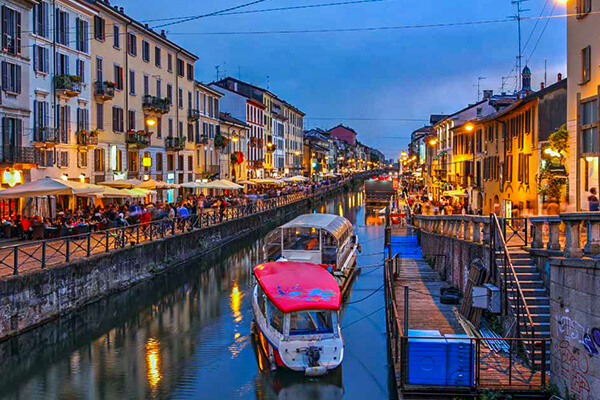
Milan’s Navigli neighborhood is a favorite because of its unique appeal and exciting nightlife. It’s a terrific area to hang out. It is stated that the city was once nearly like a landlocked Venice, with waterways that are now invisible under paved roadways.
The Navigli were formerly man-made navigable canals for irrigation and transporting products and passengers. For building the Duomo, they used marble blocks brought directly into the city’s heart through these same rivers. The canals had to be ultimately filled in to allow for vehicular traffic, but the original beauty is still there in the particular Navigli neighborhood.
History of Navigli of Milan
Milan is the most cutting-edge and contemporary of all the major Italian cities, yet there are still traces of the ancient city everywhere. This lovely neighborhood has remnants of Milan’s Roman glory; the historic district next to the 16th-century Porta Ticinese is rich with historic buildings representing the city’s past.

The Basilica di San Lorenzo, one of Milan’s oldest churches, is located directly at the top of Corso di Porta Ticinese. This church, which dates back to Roman times, has undergone several modifications throughout the ages, resulting in an incredible medley of various architectural styles.
The Basilica Sant Eustorgio is further down the road. The Portinari Chapel, Milan’s most significant Renaissance chapel, is located here, and the Vincenzo Foppa paintings from the 15th century are other exceptional works of art.
What you can do in Navigli of Milan?
Milan’s Navigli neighborhood is located just around the perimeter of the actual city center. Viale Cassala and Viale Liguria are south of this area, while Naviglio Grande and Naviglio Pavese form the other two boundaries of Navigli.
There is a sizable green space in the center of the neighborhood where locals may enjoy various leisure activities. However, the famous location in Milan’s former harbor district will still be on the sea.

You may wander over the little bridges that span the navigable canals and through the congested lanes with their massive oak doors. These streets become the ideal area for aperitifs, music, and nightlife in the evening thanks to the plethora of pubs, ethnic restaurants, and clubs that line them.
Galleries of Navigli of Milan
Milan has been intertwined with significant art movements for ages, from the Gothic, Renaissance, and Futurism ideals of the 20th century. Numerous tiny, independent art galleries, such as the Silbernagl Undergallery, are scattered around the city, and there is a wide variety of modern work to be seen there.
Also visit nearby Zona Tortona for some of the area’s most significant cultural displays. The MUDEC (Museo delle Culture di Milano), which David Chipperfield created, is a sizable destination gallery that examines the connection between many civilizations and modern art.

Shopping in Navigli of Milan
Milan, Italy’s best-dressed city and one of the world’s fashion capitals, there is always time to hit the stores. Leaving the well-known designers to the Quadrilatero della Moda, the neighborhood of Navigli is home to a vibrant independent, and vintage design culture. On both sides of the two canals, vintage businesses sprout up. There are also many small ateliers and antique shops in the little side lanes
The once-monthly flea market in Navigli is one of the most incredible places to find an antique. Every last Sunday of the month, the Mercato dell’Antiquariato takes over the Naviglio Grande’s banks and is the ideal location to find beautiful antique leather goods and furniture.
Eating foods in Navigli of Milan
To take advantage of the picture-perfect waterfront settings, Navigli is full of little boutique restaurants that cling to the edges of the canals. The contemporary dining room in the region known as 28 Posti, which can accommodate 28, is well known for its inventive take on traditional Campanian cuisine.

The trendy timber décor was originally installed by convicts of the adjacent Penitentiary Institute of Bollate, which gives the industrial-style interior a fantastic dinner table narrative. In Italy, you can’t go wrong with a traditional osteria, and one of Milan’s best is the canalside Al Pont de Ferr, which has a Michelin star.
It may appear straightforward on the interior, but the cuisine is anything but Italian “slow food” at its most interesting; the menu features a lot of handmade pasta, fresh seafood, and local grazing animals.
Drinks in Navigli of Milan
Aperitivo is celebrated in Milan, so follow the locals’ lead and go to Navigli for a drink in the early evening before supper. There are many places to sit or stand along the canal’s attractive banks, where you may enjoy cocktails, wine, or a simple spritz. Rita & Cocktails is the go-to bar for creative cocktails because of its unique flavor combinations and glass-enclosed terrace where patrons may enjoy their drinks on the charming, quiet side street.
The décor of the speakeasy-styled UGO feels more French than Italian, but the antique drinks and candelabras are what really stand out at this quaint, pre-dinner drinking establishment. If spritzes are more your style, Gin012, the gloomy gin bar next to Officina 12, is stocked to the gills with a dizzying collection of brands that make for the ideal nightcap or two.

Navigli’s vital canals
The Navigli canals were first built for agricultural purposes, irrigating fields, and power mills. Construction on them started in the 12th century. A significant amount of the stone needed to construct Milan’s Duomo was delivered to the city through the waterways, which at some point entered the city itself and, in 1386, became a source of transportation in and of themselves.
Where are other attractions of Navigli of Milan?
Visit Vicolo dei Lavandai to experience this neighborhood’s true spirit. It may be challenging to comprehend, but this lane used to be where laundresses worked in the fifteenth century. The laundry used to hang out to dry in the little homes now frequently occupied by artists. This historic old laundry needs to be seen, and fortunately, it is situated in a unique area that you will be glad to explore for a short while.
Also suggested is the Chiesa di San Cristoforo sul Naviglio, a church on a canal just outside Milan’s Navigli neighborhood. It is not a huge church, but the vastness and somber demeanor may be more stunning because of this.
The church does not appear to be very lavishly decorated with sculptures and frills from the outside, but once inside, you will be astounded by the amount of ornamentation. Because of how small the church is, you should make the occasion memorable if you visit while it’s quiet.

Conclusion
Navigli is the ideal location for experiencing Milan’s vibrant nightlife, with chic clubs, pubs, and independent shops blending into a distinctive setting that includes a mix of contemporary structures, Art Nouveau structures, and the well-known “railing houses” typical of Milanese architecture.



